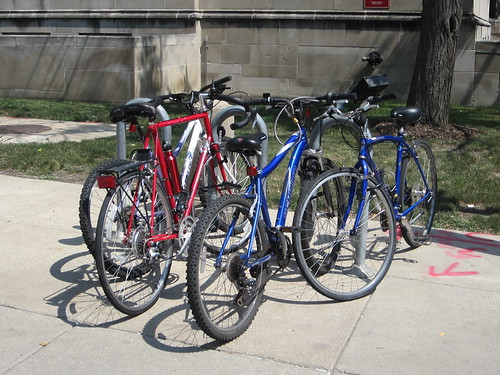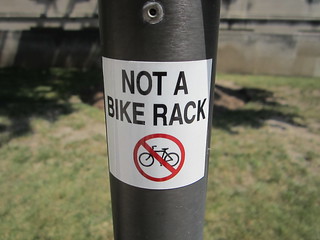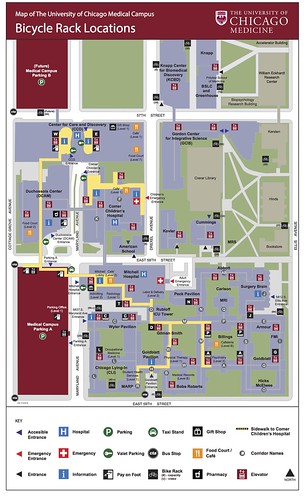Two weeks ago, Streetsblog Chicago reported that nearly every sign pole, light post, fence and handrail by University of Chicago Medical Center buildings on 59th Street, 58th Street, and Maryland Avenue sported stickers or placards reading “Not a Bike Rack.” Streetsblog reader and U. of C. employee Elizabeth Edwards had originally alerted us about the issue.
This passive-aggressive campaign to keep locked cycles out of the way of pedestrians also seemed to be illegal, since some of these poles were city-owned stop signs and No Parking signs on what appeared to be the public right of way. Chicago’s municipal code specifies that it’s legal to park bikes on sign posts on publicly owned sidewalks.
Meanwhile, on a cruise around the hospital campus, I noticed only a handful of bike racks. Some of them, such as ones at the Duchossois Center for Advanced Medicine, 5758 South Maryland, were overcrowded. “If the hospitals want to ensure that parked bikes don’t obstruct the sidewalk, a more productive strategy would be to provide a sufficient number of bike racks in convenient locations,” I wrote. “The anti-bike signs and stickers on city poles need to come down immediately.”
Happily, the medical center has followed my second suggestion. A few days after I contacted spokeswoman Lorna Wong about the issue, every single “Not a Bike Rack” sticker and placard had vanished without a trace. A few signs remain on fences, warning that locked bikes will be removed, which would be completely within the hospitals’ rights.
The question is, who put up the “Not a Bike Rack” stickers and placards in the first place? “It seems those stickers and signs were put there by someone who is no longer with UChicago Medicine,” Wong wrote shortly after I contacted her, saying she'd look into the matter.'
A commenter on the previous Streetsblog post, who formerly worked on the medical campus, offered the following reminiscence:
While I worked there, the hospital removed bike racks that were visible and replaced them with ones that were difficult to see (the accompanying e-mail called bikes unsightly or an eyesore or something like that). So there are more racks around the corner from the DCAM near the main green pavilion entrance but they're not visible to those not in the know.
At the same time they took out the staff bike cage that was in the parking garage. They were going to eliminate covered/carded staff parking entirely, but after a major outcry… they replaced it with a new carded/covered bike parking location in the courtyard of the [Chicago Lying-In Hospital] building.
They have cut bikes off of various locking locations (often then stacking them up in the way of staff bike parking in the covered location). I don't know if any of the locations they cut from were city owned. The stickers also showed up around the same time. The email read to me as though someone in upper admin had tripped over a bike and decided to go on a crusade.
Last week, Wong provided a statement from the medical center. “The signage was installed with the intent of protecting the safety of our patients and their ability to access care by minimizing obstructions and hazards to our patients, especially those in wheelchairs or with limited vision or mobility,” it read. “Upon review, some of the signage has been taken down.”
However, the statement noted that the university actually owns Maryland between 57th and 59th, and asserted that it was therefore legal for the medical campus to install notices on sign poles telling people not to lock to them. It turns out that 58th, between Cottage Grove and Ellis avenues, is also university property.
“Further, while we fully support the city’s efforts to make Chicago more bike-friendly, a bicycle may be removed if it poses a hazard to our patients or obstructs their ability to access care,” the statement concluded. “We encourage bicyclists to use the racks located in areas that are secured and protected from bad weather. They also minimize obstruction for our patients.” The message included a map showing the locations of bike racks on the medical campus.

The map tends to overstate the actual capacity of the racks. For example, a narrowly spaced “wave” rack by the Goldblatt Pavilion, 860 East 59th, is shown on the map as having space for eight bikes, when it would actually be a bit of a squeeze to fix six on it.
Nevertheless, it’s great to see that the medical center currently provides more bike parking than was obvious from a cursory spin around the campus. Maybe the “Not a Bike Rack” stickers should be replaced with signs directing cyclists to the secure, weather-protected parking.






